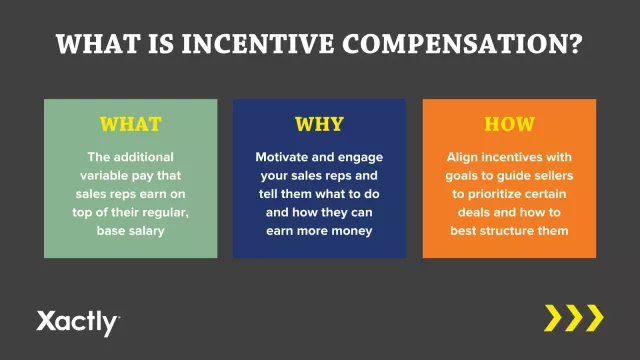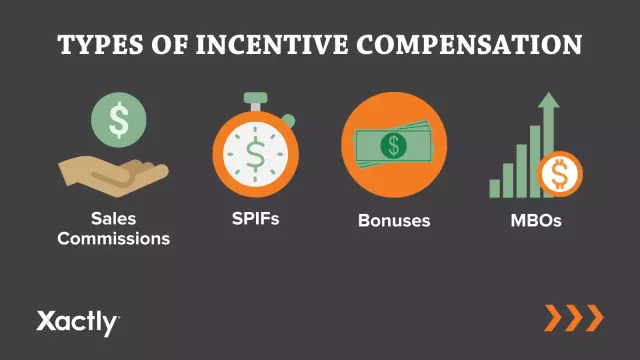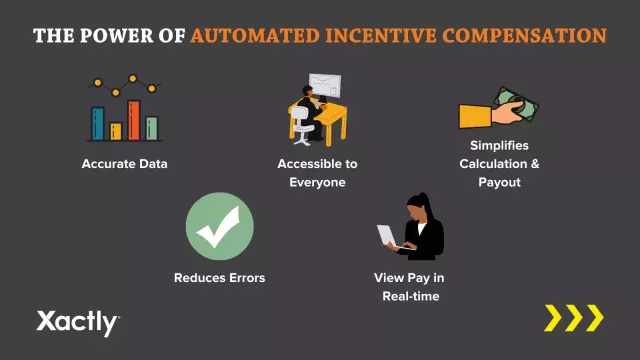
Incentive compensation is the variable income sales reps earn in addition to their base salary. This income is not guaranteed and is contingent upon the representative meeting certain goals. Learn more about types of incentive compensation, how to structure an effective incentive compensation plan as part of your company’s program, and how to maintain ongoing optimizations to reflect new business dynamics and keeping employees motivated along each pivot.
What is Incentive Compensation?
Incentive compensation is a variable payment type centered on a salesperson’s performance rather than a fixed base payment like a salary that is centered on a salesperson’s contract/employee agreement. Incentive compensation is also known as incentive pay. Although, incentive puts in mind payment in a monetary sense, there are other forms that can equally reward and motivate performance, such as awards and special recognitions.
What is Incentive Compensation Management and Its Role?
In order to best design, organize, deploy, and maintain your company’s unique incentive pay structures that your company establishes based on your workflows and goals, you will want to create an incentive compensation management (ICM) plan and system that adapts with you.
Any solid incentive compensation program will have ICM systems within its framework for organizational efficiency around compensation rules and large data handling.
The Importance of Incentive Programs
Incentives are a powerful motivational tool. They can help sales representatives stay engaged and motivated to close deals, upsell or follow up on leads, increasing the department's revenue. There are many other options for promoting best practices and inspiring good performance, but incentive compensation is perhaps the most effective option.
Companies pay incentive compensation on top of the representative's basic salary, and it is just one part of a sales compensation plan. In some cases, there may be more than one incentive program. For example, a company may reward individual representatives for their own performance with additional compensation if the entire department meets its goals.
The Goal of Incentive Compensation: Driving the Right Sales Behaviors
Incentive compensation promotes positive behaviors by showing sales reps what they can do to earn more. In a 2022 study from McKinsey, a company challenged one of their teams with a $40 million target in 40 days. With these clear and concise goals, the team over delivered on the goal and did so several days early.
Good reward structures that mesh with your organization's goals motivate sellers to prioritize the deals that will meet those goals. This could help encourage sales reps to upsell, promote higher-margin offers or more proactively pursue leads in their work.
Key Types of Incentive Compensation
There are several forms of compensation you can use to motivate your sales team. Some examples of incentive-based compensation are:
- Sales Commission Structures: This is the most common form of incentive compensation. Commission structures can be as simple as paying a sales representative a fixed amount per sale or a straight percentage of revenue from every deal closed (known as a “straight commission”). Some commission structures are more complex, taking into account the percentage of quota completion.
- Sales Performance Incentive Fund (SPIFs): SPIFs are a highly effective short-term incentive when used with a sales commission structure. Companies can employ SPIFs to encourage a sales representative to focus on a specific product in the run-up to a new launch or to increase sales volume for a short period.
- Bonuses: Bonuses motivate both sellers and non-sales employees to work toward specific initiatives. A bonus is usually a fixed amount, paid out to an individual when they meet their targets. Companies can also award bonuses on a department-wide (or company-wide) level for meeting broader goals.
- MBOs: Companies can use Management by Objectives, or MBOs, to encourage sales reps which are also useful for incentivizing non-sales employees to meet individual goals set by a manager.
- Non-Monetary Recognition: Companies can explore other enriching motivators such as gift cards, trips, special PTO, or other means of public recognition that show their sales reps that they are valued.
Designing an Effective Compensation Plan
For an incentive program to work effectively, the program must receive buy-in from management and the sales representatives themselves. Consider using a phased approach to designing and introducing a new compensation plan:
- Design phase: A short period where the initial ideas for the program are drawn up.
- Consultation phase: Key stakeholders review, discuss and revise the proposed program.
- Implementation phase: The company implements the program and monitors its performance.
- Review phase: An ongoing phase where the company reviews, changes and monitors the program based on organizational performance.
The nature of the incentive compensation program and the duration of each phase may vary depending on the organization's size. When considering sales incentive management, it's important to look at not only the monetary value of the rewards but also what behaviors they encourage.
For example, a program could incentivize:
- The volume of items sold.
- How many times a specific package was upsold.
- Additional rewards for promoting a loyalty program.
Where an employee incentive compensation plan focuses on a specific issue such as upselling or attracting customers to a loyalty program, it's essential a company clearly promotes these conditions so the sales team understands how to get the most from their incentive pay.
Team vs. Individual Incentives
There are many arguments for and against employing team incentives. In general, individual incentives are an effective way of motivating employees, especially the strongest performers. However, in some organizations, it is hard to measure an individual employee's performance. Therefore, the best option is to provide sales incentive compensation at a team level. Some environments lend themselves to a hybrid approach, where the best performers on a team have the opportunity to earn an additional bonus on top of the allocation for the team as a whole.
Pros and Cons of Individual Incentives
Pros:
- The top performers feel well rewarded.
- There's a clear line between strong and weak sales performers.
- This kind of variable incentive compensation plan creates a strong emphasis on sales.
Cons:
- Weaker sales staff may feel demotivated.
- Sales staff may compete against each other, creating a negative work environment.
- Sales staff may grow to overfocus on the amount of work output over time at the sacrifice of other factors if their employer’s primary incentive pay determinant is work volume rather than work quality.
Pros and Cons of Team Incentives
Pros:
- Sales representatives are encouraged to work together.
- The emphasis is placed on fulfilling customer needs rather than chasing credit for sales.
- Fewer disputes about who deserves credit for a sale.
Cons:
- Stronger performers may feel they're carrying weaker performers.
- It's harder for employers to tell what factors impact performance when measured at a group level.
- Top performers may leave the company for somewhere offering higher potential compensation.
ICM vs. Sales Performance Management
In addition to ICM, many organizations can benefit from using Sales Performance Management (SPM). There is a significant overlap between ICM and SPM, and the two practices can augment each other. Where ICM focuses on collecting data about sales, crediting the correct agent with the sale and compensating them, SPM takes a broader view, with capabilities including:
- Designing and building sales models
- Defining/allocating quotas
- Quota agreements
- Administration and reporting
- Sales coaching
- Sales operation analysis
When these tools are combined, they help businesses not only calculate incentive pay but also find areas where sales representatives may need support and training to help them earn these incentives. Through monitoring and coaching, sales staff can gain the tools they need to improve their performance.
Optimizing Your Incentive Compensation Programs for Maximum Benefit
For proper incentive compensation management, employees should clearly understand how the program works and know what they can expect based on their performance. Straight commission bonuses are the easiest to calculate and optimize since companies pay them as a fixed amount based on the employee's performance.
Calculating department-level bonuses can be more complex. If a department has eight employees and the budget for a bonus this quarter is $15,000, each employee can expect a maximum bonus of $1,875 ($15,000 / 8). Managers must decide whether it makes sense to tie this bonus to individual achievement. For example, they can have tiered goals for sales representatives to meet to encourage those who may not be top-performers to still make an effort to earn a portion of the bonus.
Bonus amounts are just one part of the equation. Next, the bonuses and other incentives should align with your company’s goals from a whole rather than the parts approach. Your incentive compensation plan and management should be around developing incentives that encourage teamwide motivation rather than individual motivation on a case-by-case basis to improve employee performance.
This also means that not just one type of improvement, higher sales targets, should be the performance goal for which your sales reps are rewarded. Instead, all-around improvements should be incentivized, such as decreasing turnover while also hitting those sales targets.
Finally, the last and often challenge is tracking the performance of each sales representative, and the team as a whole, so companies can accurately award any incentives.
Automating Incentive Compensation Management
The process of managing, calculating, and paying reps their earned commissions is known as Incentive Compensation Management (ICM). This process involves far more than just writing sales reps their paychecks. You need to be able to calculate seller pay and look at the effectiveness of your sales incentive plans through accessible reports, calculations, and real-time tracking at minimum.
Using Incentive Compensation Management solutions ensures your compensation data is accurate and in one place for everyone in the organization to access. Having easy access to sales data means you can improve your compensation even more by benchmarking it against industry pay insights. Comparing your compensation against your industry allows you to develop competitive incentives that attract and retain top talent.
In addition, an ICM may allow sales representatives to view their own performance and compensation data in real time. This can boost morale and improve retention, as representatives feel more motivated and recognized for their performance. Retention is critical for today’s organizations, considering 58% of organizations experienced increased turnover in the past 12 months.
Discover more ways you can improve your sales incentive compensation planning and management in the “2021 Guide to Successfully Managing Sales Compensation.”
Key Features of the Right Incentive Compensation Management Tool
At the heart of any effective incentive compensation tracking, there should be at-scale customizations and automations that can change alongside your company’s ever-changing business dynamics. Here are key features to look for:
- Real-Time Tracking: Your company’s incentive compensation software should present valuable data and metrics around your employees’ targets and other benchmarks so that you can stay informed.
- Customizations: Reports and dashboards should be nimble, much like your company’s operations for continued trend and performance analyses that will inform your decisions soundly.
- Compliance: Following the latest incentive compensation rules such as legal, financial, and regulatory standards within your incentive compensation programs are key for continued employee and company success.
- Automated workflows: Not only should automated calculations be implemented to avoid manual errors and work overload, but streamlined processes at large will ensure accuracy and greater efficiency.
With the right incentive compensation management and planning software, employee incentive pay and processes to keep it measurable and successful are much more attainable and trackable.
Ready to motivate your company’s team performance for the greater performance of your enterprise? Request our compensation administrative demo to see how our Xactly Incent tool helps businesses like yours with flexibility and scalability.


